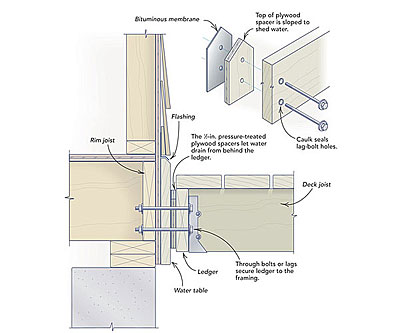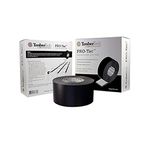Q:
The deck on our six-year-old home needs help. The deck boards and joists are in good shape, but the deck joists were attached directly to the water table. Although a metal cap was used, the water table is failing. I can replace the water table and flashing, but what is the best method of reattaching the deck to keep rot from reoccurring?
Mark Suchland, Glencoe, MO
A:
Scott Schuttner, author of Building and Designing Decks , replies: Joists or deck boards in direct contact with the water table may wick water back toward the house, where it could be trapped or leak through siding penetrations. So the first order of business is to remove all rot down to solid wood. Replace the water table with good, solid lumber, and make sure the flashing is installed properly to divert rainwater.
To reattach the deck the right way, you need to follow a few basic principles. Always support deck joists on a ledger rather than attaching them to the house itself, even if you have a big, beefy water table where the deck will be fastened. A ledger is a horizontal framing member attached to the house that supports one end of the deck joists. It can be attached to almost any part of the house from a concrete foundation to the rim joist to the wall framing, if the fasteners are the right size and can get adequate purchase, and if the attachment area can support the extra weight of the deck. Attaching a ledger to a foundation usually requires concrete anchors, while woodframe attachment requires lag bolts or, preferably, through bolts.
The ledger also must be attached in a way to prevent water intrusion. The ledger can be attached over flat siding such as T-111 or over the lower part of a water table, as in the case here, without removing the siding or water table. The siding or water table must be in good shape and must lie flat so that it doesn’t crack or distort under the pressure of the ledger bolts.
In this scenario, it is important to ensure drainage behind the ledger by holding it about 1/2 in. away from the siding with treated plywood spacers or stacks of washers. If using plywood spacers, slope the tops of the spacers so that they shed water, and add a layer of bituminous membrane. After making sure that the decking or ledger doesn’t directly contact the siding or water table, be sure that the joists slope away from the house slightly to keep water from running back toward the house. Finally, use good caulking around fasteners, spacers and siding to seal bolt penetrations, and always use joist hangers to attach the deck joists to the ledger.

Fine Homebuilding Recommended Products
Fine Homebuilding receives a commission for items purchased through links on this site, including Amazon Associates and other affiliate advertising programs.

MicroFoam Nitrile Coated Work Gloves

Flashing and Joist Tape

4-Gallon Piston Backpack Sprayer

























